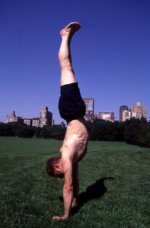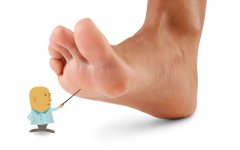I am just making sure that you understand this: your weight is on your heels in the video and it should not be. Your weight should be on the balls of your feet which means you need to shift your weight forward. As you do, your heels should come up off the ground a very small amount.
In the following video, they show a nice closeup of the feet and how the weight should be on the balls of the feet so the heels come up a tiny bit:
That was what I am talking about. It is hard to have your torso too upright if you have your weight forward and in the balls of the feet the way Petr Korbel shows in this video. You can also see his slight reset of his feet after each stroke when they show his feet during the stroke. This is really a great video for good fundamentals on FH and BH.
I have training as a movement analyst. A decent amount of what I do is help people fix dysfunctional movement patterns and replace them with ones that won't cause injuries. The movements of normal life are much more simple than the movements of Table Tennis. There was a point where, with TT, I could not actually see what was happening, because there are so many things that happen in table tennis that are very subtle. Without the training I have, I would not be able to see so much. And, even though I can see stuff at a higher level than I can play TT, real coaches who are 2500+ can see much more and see it faster then I can. So, for a guy who plays for fun, I can analyze things okay. And trust me, every time I see footage of me playing, I see lots of things to work on.
The words are wrong, but perhaps you know what I mean, and perhaps you don't. So, I am going to try and make sure you know what I mean.
Pivoting from the elbow and pivoting from the forearm sound like they are the same thing. The joint that moves the forearm is the elbow (well, sort of, but the rotation of the upper arm that comes from the shoulder joint still uses the elbow as a pivot--you will see what I am talking about in the video I just made). Forearm is the part of the arm (radius and ulna) and the elbow is the joint that the forearm is moving from. In the movement that I am talking about, there would also be rotation from the shoulder. You will see it in the video. But to keep things simple: elbow stable, forearm moves from the elbow joint.
You are moving the upper arm (humerus) from shoulder extension so your elbow moves forward more than you want. At least in the video above. But, again, I think you are just doing that because it fits the circumstance of how you are hitting and who you are hitting with in the video you posted. But just so the things I am saying are clear, lets see if I can video what I am talking about.
Now, if you look at the video of Petr Korbel when he is hitting his BH, his upper arm does move his elbow forward a little but there is so much whip from the rotation at the elbow and sometimes you need to isolate that movement to get it really fully. In a real backhand, there will be some of both movements. But to really get the acceleration and whipping action of the racket, you need to be able to do the shot with the elbow stable first. And, in your video, your arm is not moving forward as much as in my video. I am exaggerating the movement to make the difference clear.
Hope this makes things more clear.
















